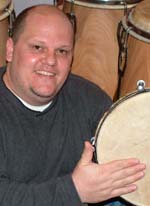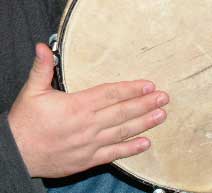Rhythms of Puerto Rico
 Part
1: Plena Part
1: Plena
By Jorge Ginorio
The origins of the musical form known as Plena can be traced
back to the early 1900's. It originated on Puerto Rico's
southern coast, in a sector known as La Joya del Castillo, ("Jewel
of the Castle"), located on Castillo street in the city of
Ponce. Plena functions as a sort of singing newspaper in which barrio
residents recount events and scandals of the day.
The main percussion instruments used in plena are three panderetas,
(single-headed hand held frame drums), also known as panderos, and
a güícharo (gourd scraper). The names of the panderetas
from low to high are Seguidor, Segundo or Punteador (also known
as "Banao" in the area of Santurce), and Requinto.
In the plena ensemble, the seguidor, punteador and güícharo
establish the basic plena rhythm while the requinto improvises,
creating rhythmic interaction with the call and response vocals
and the melodic instruments.
Modern panderetas are made of different types of materials such
as wood, steel, and fiberglass. They utilize tuning hardware quite
similar to that found on timbales. Panderetas are headed with goatskin.
The tuning is fairly tight, and each drum feels and sounds more
like a conga than many frame drums. The basic sound for the seguidor
and the punteador is the open tone, while the requinto has two basic
sounds, the slap and the open tone.
 In the
old tradition of plena known as "Punta de Clavo", requinto
players used their fingers more in their playing style, according
to Hector "Tito" Matos, (Plena expert and director of
the New York base plena group Viento de Agua). Pleneros del Quinto
Olivo established a new way of playing in which the whole hand is
used (similar to the "conga drum" technique). Today, this
has become the standard way of playing, especially for the requinto. In the
old tradition of plena known as "Punta de Clavo", requinto
players used their fingers more in their playing style, according
to Hector "Tito" Matos, (Plena expert and director of
the New York base plena group Viento de Agua). Pleneros del Quinto
Olivo established a new way of playing in which the whole hand is
used (similar to the "conga drum" technique). Today, this
has become the standard way of playing, especially for the requinto.
In Puerto Rico plena is played at different tempos in different
regions. For example, plena from Ponce is usually slower from plena
of Santurce. Also within the Plena genre there are some variants
such as; Plena Lamento (a very slow tempo plena with lyrics of sadness
and melancholy), Plena Poética (a medium tempo plena with
poetic verses adapted to the lyrics), and Plena con Mambo (a fast
tempo plena with a very short "Coro", also known as "Coro
Picao"). the latter is the preferred variant by contemporary
Plena groups like; Plena Libre,
Plenéalo, Viento de Agua, and Truco y Zaperoko.
Some of the major exponents of Plena, (past and present), are:
Joselino "Bumbúm" Openheimer, "Los Ingleses",
Aranzamendi Brothers, Mario Rivera, Manuel "Canario" Jiménez,
Marcial Reyes, César Concepción, Orquesta Panamericana
de Lito Peña, Grupo ABC, Hermanos Santana, Rafael Cortijo
e Ismael Rivera, "Mon" Rivera, Familia Cepeda, Hermanos
Ayala, Pleneros del Quinto Olivo, Grupo Atabal, Paracumbé,
Plena Libre, Plenéalo, Plena
Dulzura, Golpe de Plena, Pleneros
de la 21, Viento de Agua, Truco y Zaperoko, among others.
©2003 Jorge Ginorio
(stu writes) So there you have it: an indroduction to Plena. This
is just the begining. More about the "Punta de Clavo"
style and the "Banao" from Santurce. Stay tuned! :-)
|

